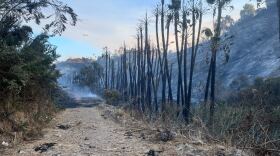Thousands of San Diegans enjoyed viewing Monday's solar eclipse at events around the city as 57 percent of the sun was blocked by the moon.
At least 3,000 people crowded into the plaza outside the Fleet Science Center in Balboa Park, watching the celestial phenomenon through special solar glasses, telescopes, a variety of pinhole viewers and a NASA broadcast.
"This is one of the reasons why an event like a solar eclipse is so powerful, because it is a shared experience," said Lisa Will, the Fleet's resident astronomer. "It's not just one person, it's a bunch of people."
The morning marine layer burned off just in time for cloudless viewing of the eclipse, which began in San Diego shortly after 9 a.m. and reached its height at 10:23 a.m.

RELATED: Be Smart: A Partial Eclipse Can Fry Your Naked Eyes
It was the first total eclipse visible in the United States since 1979 in a 100-mile-wide swath of the country from Oregon to South Carolina.
Will said scientists will learn a lot about what happens in the corona, around the edge of the sun, but also what happens here on earth.
"Having such a large populated area having the eclipse totality stretch across, we're going to get all sorts of interesting temperature data, how is the atmosphere reacting to the temperature changes, we're going to learn all sorts of stuff about our own atmosphere," said Will, also a professor at San Diego City College.
"It's not just the sun that we learn about, but the sun and Earth are connected," she said.
RELATED: Where To See The Total Solar Eclipse In San Diego
Those who came out to the Fleet brought with them all kinds of pinhole viewers, including colanders, cereal boxes, Ritz crackers and a small plastic household trash can.
Museum officials also pointed out how the shadows of leaves on the ground formed crescent patterns, and even the shadow from chain-link fencing curved on the ground.
William Oliver was part of a San Diego Astronomy Association contingent helping people get an up-close look at the eclipse through telescopes outfitted with solar filters. He was thrilled to see so many locals turning out.
"This is amazing, to see this many people," Oliver said. "Because I know that all of them are out here for the eclipse, for the science. It's absolutely amazing to see that people are taking an interest in an event that won't happen again for a long time here in the United States."
Five city library branches displayed the NASA "megacast," which showed the eclipse from 11 spacecraft, at least three NASA aircraft, more than 50 high-altitude balloons and the astronauts aboard the International Space Station. In all, 27 city library branches held viewing events.
The next solar eclipse visible in San Diego will be in 2023, according to the museum.

RELATED: San Diego Eclipse Chasers Travel North For The Total Experience






